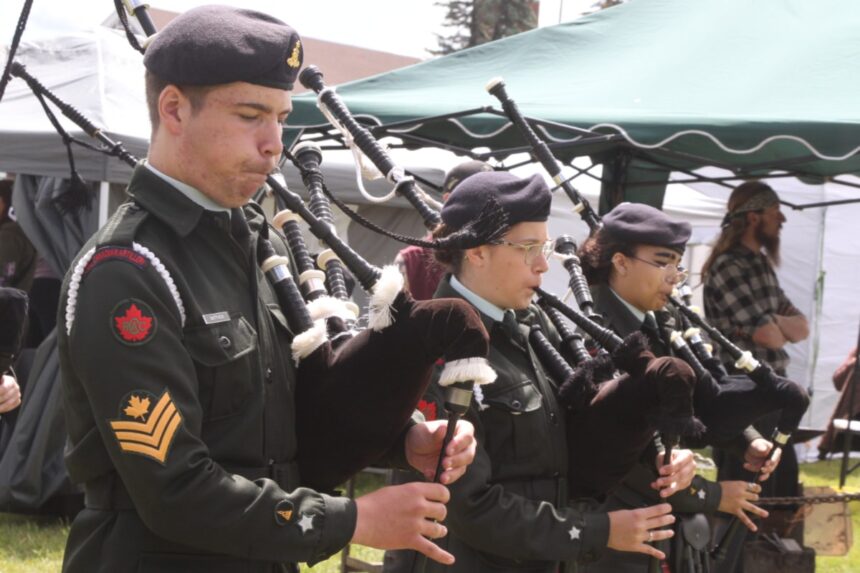The sun broke through the morning clouds as I arrived at Westerner Park last Saturday, greeted by the unmistakable drone of bagpipes. Children with faces painted blue like William Wallace raced past me, while vendors arranged shortbread and tartan scarves under white tents. This scene has played out for generations in Red Deer, and this year marked the 78th annual Highland Games – a testament to the enduring Scottish heritage that runs deep in Alberta’s cultural bedrock.
“This isn’t just about celebrating our ancestors,” explained Moira MacDonald, whose grandfather helped establish the Games in 1947. “It’s about keeping traditions alive and passing them on.” MacDonald, now 67, has attended the event every year since childhood. As we spoke, she adjusted her clan’s tartan pin, a MacDonald crest that’s traveled from the Scottish Highlands to the Alberta prairies.
The Games drew over 2,500 visitors this year, according to event organizer Colin Campbell. “We’ve seen a resurgence of interest in Scottish heritage, especially among younger generations trying to connect with their roots,” Campbell told me while overseeing the heavy events competition.
On the main field, competitors in the heavy events hurled cabers – telephone pole-sized logs that must be flipped end-over-end. The feat requires both raw strength and precise technique. Nearby, stone-putters prepared for their event, some traveling from as far as Nova Scotia and British Columbia to compete.
“The technique is everything,” said James McPherson, 32, this year’s caber toss champion who’s been competing for over a decade. “It’s not just about brute strength. There’s a rhythm and balance you develop over years.” McPherson’s family has participated in Highland Games across Canada for three generations.
Throughout the day, the sounds of competition blended with cultural performances. The Red Deer Pipe Band, celebrating its 75th anniversary, performed alongside highland dancers from across Alberta. Young dancers as young as five performed intricate steps of the Highland Fling and Sword Dance, their movements preserving centuries-old traditions.
The Games’ cultural significance extends beyond sport. According to Statistics Canada, approximately 15.8% of Albertans claim Scottish ancestry, making Scots one of the province’s largest ethnic groups. The Highland Games serve as both celebration and living history museum.
Margaret Ross, a cultural historian at the University of Calgary, believes these community celebrations play a crucial role in preserving cultural heritage. “In our increasingly digital world, these physical gatherings where traditions are performed and shared become even more significant,” Ross explained in a recent paper on Canadian cultural festivals.
I wandered through the clan tents where volunteers helped visitors trace their Scottish ancestry. Janet Fraser, representing Clan Fraser, showed me faded photographs and handwritten family trees. “Every year, someone discovers a connection they never knew about,” she said, pointing to a map of Scotland divided into ancestral territories. “That moment when they realize their place in this continuing story – that’s what makes volunteering here worthwhile.”
The Games aren’t simply a historical reenactment. They’ve evolved to include contemporary elements while honoring traditional roots. This year featured a whisky tasting pavilion showcasing both Scottish classics and newer Canadian distilleries, including Troubled Monk from Red Deer itself.
Food vendors offered everything from traditional haggis to fusion dishes like “haggis poutine” – a uniquely Canadian adaptation that drew long lines. Children participated in mini highland games, attempting scaled-down versions of the traditional heavy events.
The Central Alberta Scottish Country Dancers performed throughout the day, inviting spectators to join impromptu dance lessons. “The best way to preserve these traditions is to participate in them,” explained dance instructor Fiona MacKenzie. “We’re not performing for an audience so much as keeping something alive by sharing it.”
As afternoon turned to evening, the closing ceremony began with a mass pipe band performance. Nearly a hundred pipers and drummers from across Alberta gathered to play “Scotland the Brave” and “Amazing Grace,” creating a wall of sound that echoed across the grounds.
For many attendees, the Games represent a chance to reconnect with a cultural identity that might otherwise fade away. Emily Stewart, 23, attended with her grandfather. “I grew up hearing his stories about Scotland, but this makes it real,” she told me. “I’m learning these songs and stories so I can pass them on someday.”
The Red Deer Highland Games demonstrate how cultural traditions can remain vibrant across generations and continents. They’ve survived through nearly eight decades of social change precisely because they’ve managed to balance tradition with adaptation.
“We’re already planning for our 80th anniversary,” Campbell mentioned as the day concluded. “These traditions have survived for centuries. With each new generation participating, they’ll continue for centuries more.”
As the sun set over Westerner Park and families packed up their lawn chairs, the distinct impression remained that I’d witnessed something more significant than a single day’s festival. I’d seen the living thread of cultural continuity – one that stretches from the Scottish Highlands of the past to the Alberta prairies of today and into whatever future lies ahead.






